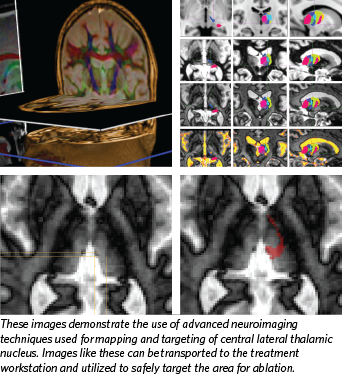Participants Needed for Clinical Trial of Focused Ultrasound for Trigeminal Neuralgia
July 02, 2021 Focused Ultrasound Research Study
The University of Maryland School of Medicine has launched a clinical trial investigating focused ultrasound to treat trigeminal neuralgia, a chronic and disabling pain condition.
A team at the University of Maryland School of Medicine (UMSOM) and the University of Maryland Medical Center (UMMC) have launched a new clinical trial investigating the use of focused ultrasound to address trigeminal neuralgia, a chronic and disabling pain condition. The trial is led by Dheeraj Gandhi, MD, professor of diagnostic radiology and nuclear medicine at UMSOM, and director of interventional neuroradiology at UMMC.
Researchers are using focused ultrasound to ablate — or destroy — a small nucleus in the thalamus, located deep within the brain. This nucleus, called the central lateral nucleus, is known to play a role in pain perception and transmission in patients with chronic pain conditions such as trigeminal neuralgia. MR scans conducted prior to treatment will help the team identify the target and plan the precise treatment.
Trigeminal neuralgia is a disorder involving the trigeminal nerve, which carries sensation from the face to the brain. Patients oftentimes present with pain affecting half of their face or specific areas in the forehead, cheek, or jaw. Symptoms can range from mild to severe pain and can happen spontaneously or be triggered with mild stimulation, such as brushing teeth, applying makeup, or even smiling and talking.
“For these patients, living in constant fear of having the next episode can be just as traumatic as the condition itself,” explains Gandhi. “Trigeminal neuralgia is often treated initially with medications, though many common pain medications, including opioids, do not generally work well. We have found that anticonvulsant medications — used to treat seizure disorders — are the best at managing the pain, but they come with unwanted side effects. We are optimistic that focused ultrasound will be able to offer a bit of hope and relief for these patients for whom other treatments have not worked well.”
In all, 10 patients with primary trigeminal neuralgia will take part in the trial and undergo a single, noninvasive focused ultrasound procedure using the Insightec’s Exablate Neuro device. Their symptoms will be assessed using several pain scales and self-reported measures by the patients before and after treatment over six months.
This trial builds upon another study also led by Gandhi at UMSOM exploring focused ultrasound for neuropathic pain in the body.
“Trigeminal neuralgia is a type of neuropathic pain, but has unique mechanisms of pain production, generation and transmission within the brain," he says. "Trigeminal neuralgia patients are largely a more homogenous group than typically encountered in peripheral neuropathic pain conditions. We have seen preliminary success in alleviating pain for those patients, and we now look forward to building upon that research with this trial.”
The Focused Ultrasound Foundation is funding both ongoing pain trials where patients are treated at UMMC.
This trial is open to patients with primary trigeminal neuralgia, including those who have tried but not benefited from other treatments. To learn more about this trial, please contact:
Kaitlyn Henry
410-328-0939
KHenry@som.umaryland.edu
Ranyah Almardawi, MBBS/MPH
410-328-5562
ranyahalmardawie@umm.edu